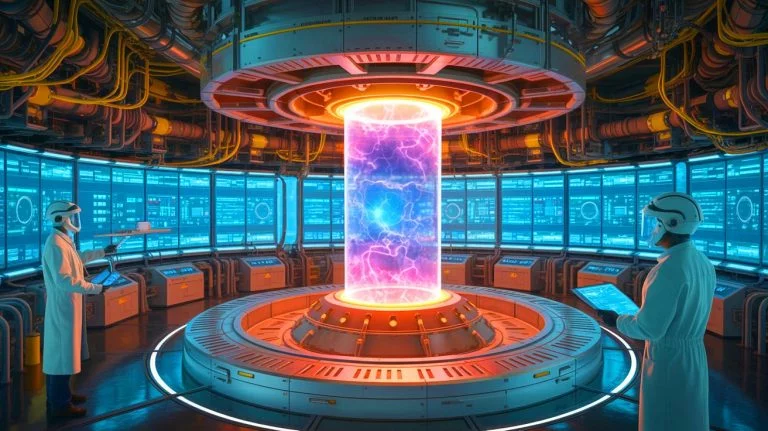| IN A NUTSHELL |
|
Amid growing concerns over climate change and the need for sustainable energy solutions, recent advancements in fusion reactor technology offer a promising glimpse into a future of limitless energy. Through a collaborative effort involving Commonwealth Fusion Systems and other leading research institutions, groundbreaking simulations have been conducted to manage extreme temperatures in fusion reactors. These advancements could revolutionize energy production, providing a clean, carbon-free alternative to fossil fuels. Let’s delve deeper into the details of this exciting development and its potential impact on our energy landscape.
Breaking Through: Temperature Management in Fusion Reactors
In the quest for sustainable energy, the management of extreme temperatures in fusion reactors has been a significant challenge. Recent simulations have shed light on innovative solutions for this problem. Using the M3D-C1 computational code from the Princeton Plasma Physics Laboratory (PPPL), researchers have developed a gas-injection system to effectively manage the intense heat within the tokamak reactor. This doughnut-shaped reactor requires precise temperature control to prevent damage. The simulations revealed that strategically placing six valves around the reactor optimizes protection and maximizes space. These findings highlight the potential of fusion technology to provide a nearly limitless energy source by mimicking the processes that power stars, such as our sun.
The Role of Collaboration in Fusion Advancements
The progress in fusion technology is a testament to successful public-private partnerships. The SPARC project, involving Commonwealth Fusion Systems, the U.S. Department of Energy’s PPPL, the Massachusetts Institute of Technology, and General Atomics, exemplifies the power of collaboration. Together, these organizations have pushed the boundaries of what is possible in fusion research. PPPL deputy head of theory, Nate Ferraro, emphasized the comprehensive nature of the disruption simulations, describing them as the most detailed to date. This level of accuracy in modeling was previously unattainable, showcasing the importance of cutting-edge research and teamwork in advancing fusion technology.
The Promise of Fusion Energy: A Clean, Sustainable Future
Fusion energy holds the promise of transforming the global energy landscape. Unlike traditional fossil fuels, fusion produces no carbon emissions, making it a key player in combating climate change. If successful, fusion could complement existing renewable energy sources such as solar and wind power. Just 132 pounds of hydrogen-rich fuels like deuterium and tritium can generate energy equivalent to over 300,000 tons of petrol. This efficiency could significantly reduce energy costs for consumers and aid in achieving climate goals by minimizing carbon pollution. The potential of fusion energy is immense, offering a sustainable solution to the world’s growing energy demands.
Looking Ahead: The Future of Fusion Energy
Building on these breakthroughs, Commonwealth Fusion Systems has ambitious plans for the future. The company aims to construct the world’s first grid-scale fusion power plant, ARC, in Chesterfield County, Virginia. By 2030, this plant is expected to provide 400 megawatts of clean, zero-carbon power, enough to supply 150,000 homes or cater to large industrial customers. This project represents a significant step toward making fusion a viable and scalable energy source. As research and development continue, the potential for fusion energy to reshape the energy sector becomes increasingly tangible. Such advancements could lead to a future where carbon-free energy is the norm, contributing to a healthier planet.
As fusion technology continues to evolve, it raises exciting possibilities for the future of energy production. The collaboration and innovation driving these advancements highlight the potential for fusion to become a cornerstone of sustainable energy solutions. What further breakthroughs will we witness in the realm of fusion energy, and how might they shape our approach to powering the planet?
Did you like it? 4.5/5 (26)







Wow, this sounds like a game-changer! When can we expect this tech in our homes? 🔥
I’m excited, but what about the cost of building these reactors?
Sounds like sci-fi! When do we get flying cars? 🚗💨
This could revolutionize energy supply for developing countries. Truly groundbreaking!
What are the environmental impacts of building and maintaining these fusion reactors?
Is this technology scalable? Can it be implemented worldwide?
Thank you for the comprehensive breakdown. Really appreciate the insights!
Infinite power and no pollution? Take my money! 💸
If this is true, why isn’t it on every news channel right now? 🤔
I’m curious, how long did it take to reach this breakthrough?
Hope this isn’t just another hype. We’ve been let down before.
Fusion energy by 2030? Can’t wait to see it happen!
With this tech, maybe we can finally tackle climate change head-on.
How reliable is the computational code used in the simulations?
Fusion reactors sound cool, but I still want my solar panels! 🌞
How will this affect the energy market and energy prices?
So happy to see progress in clean energy. Keep up the great work!
Infinite power? I guess Tony Stark was right all along! 😄
What kind of fuel do these reactors use? Is it easily available?
Is this technology safe for densely populated areas?
How does this fusion technology differ from traditional nuclear power?
Can fusion energy help reduce global reliance on oil?
Finally, a solution that might actually work! Fingers crossed! 🤞
Thank you for the detailed article. It gives me hope for a cleaner future! 🌍
Will this fusion power plant in Virginia create new jobs?
Thanks for the article! Could you cover more on the potential challenges?
Hope this is the start of an energy revolution. Let’s make it happen! 🚀
I’m a bit skeptical. Infinite power sounds too good to be true. What’s the catch?
Is there any risk of nuclear meltdown with these fusion reactors?
Amazing! Just imagine, no more fossil fuels! 🌱
How does this compare to current solar and wind technologies in terms of efficiency?
Hope this doesn’t end up as another “cold fusion” story. We’ve been burned before!
Skeptical but hopeful. Can you provide more technical details on the fusion process?
Great to see such collaboration between institutions. Teamwork makes the dream work! 🤝